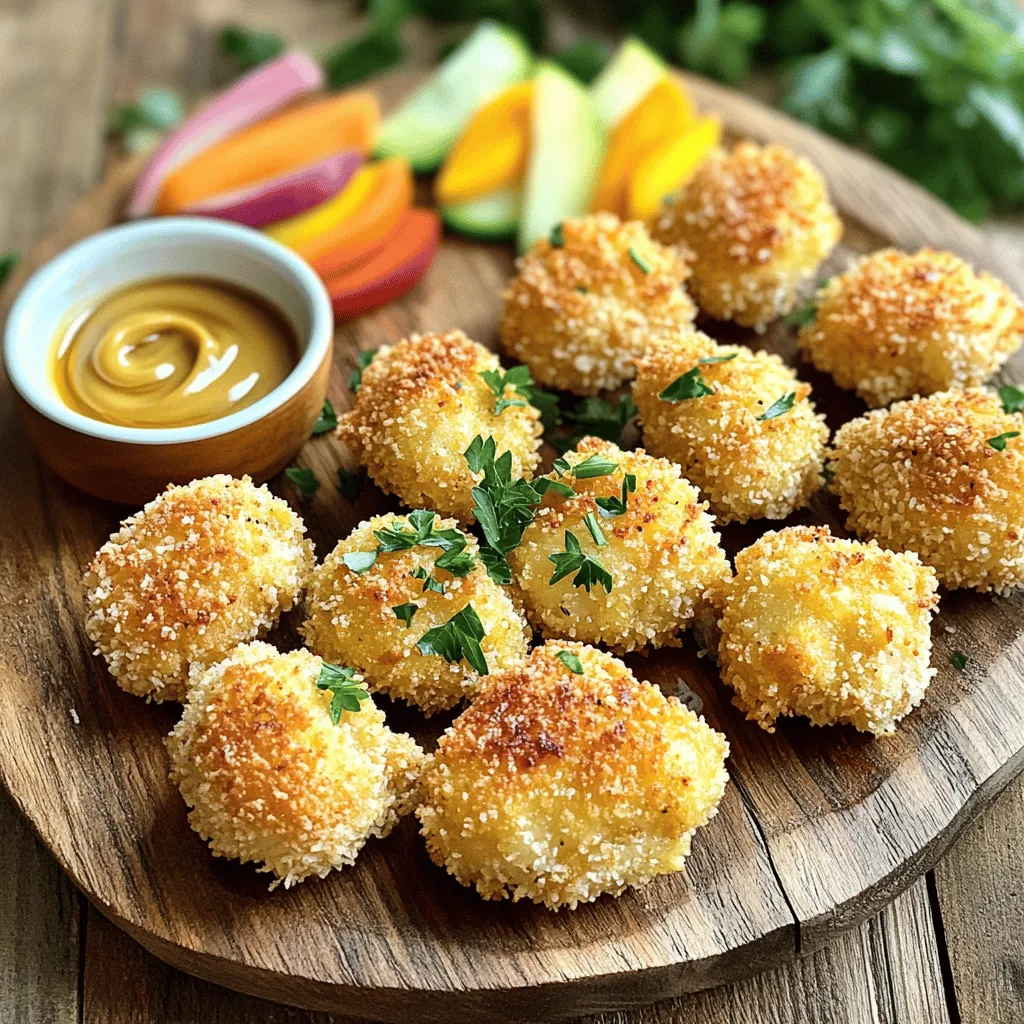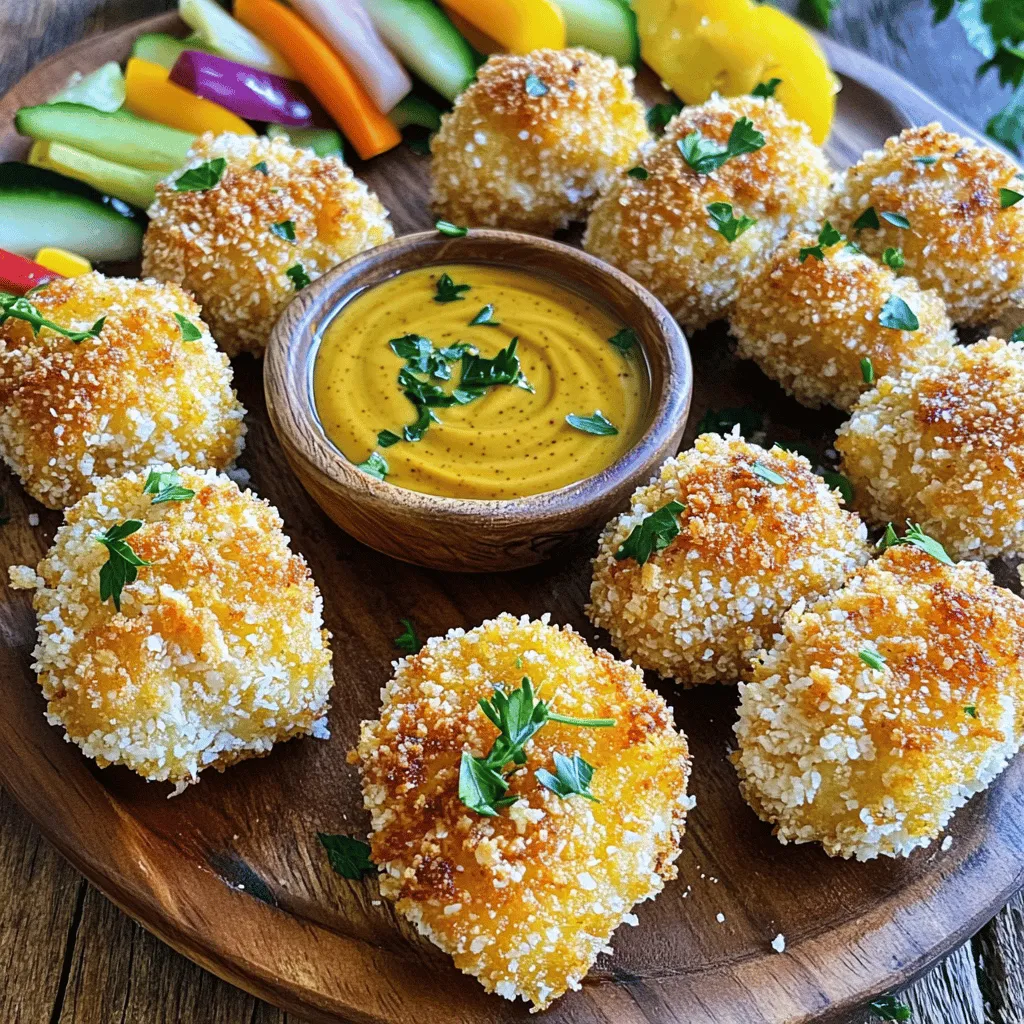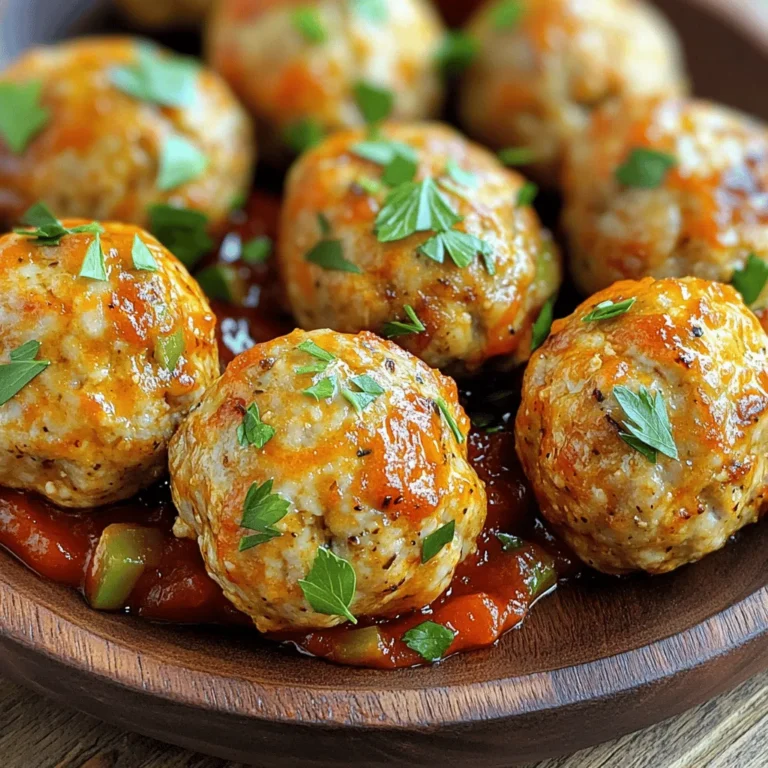Honey Mustard Chicken Bites Air Fryer Delight

Looking for a quick, delicious meal that’s packed with flavor? You’ll love honey mustard chicken bites! Cooking them in an air fryer makes the chicken extra crispy without all the oil. In this guide, I’ll walk you through the simple steps to make these easy bites. Whether for a family dinner or a party snack, you’ll impress everyone with this tasty dish. Let’s dive in and whip up your new favorite treat!
Ingredients
Main Ingredients
– 1 lb boneless, skinless chicken breasts
– 1/4 cup honey
– 1/4 cup Dijon mustard
– 1 tablespoon olive oil
Seasoning and Breadcrumbs
– 1 teaspoon garlic powder
– 1/2 teaspoon smoked paprika
– 1/4 teaspoon black pepper
– 1/4 teaspoon salt
– 1 cup panko breadcrumbs
Optional Garnish
– Fresh parsley, chopped
Gather these simple ingredients to make your honey mustard chicken bites. The chicken should be fresh and cut into small pieces. Honey and Dijon mustard blend for a sweet and tangy taste. The olive oil helps the chicken stay juicy and adds flavor.
For seasoning, garlic powder gives a nice touch. Smoked paprika adds depth and a hint of smokiness. Black pepper and salt enhance all the flavors. The star of the coating is panko breadcrumbs, which make the bites crispy.
If you want to make your dish pop, fresh parsley is great for garnish. It adds color and freshness. This is a fun dish that you can prepare in no time!
Step-by-Step Instructions
Preparation of Marinade
In a medium bowl, I whisk together the honey, Dijon mustard, olive oil, garlic powder, smoked paprika, black pepper, and salt. This mix creates a sweet and tangy sauce that adds flavor to the chicken.
Marinating Chicken
Next, I toss the chicken pieces in the honey mustard mixture. Make sure every piece is well coated. I recommend marinating for at least 15 minutes. You can also refrigerate the chicken for up to 1 hour for deeper flavor.
Air Fryer Setup
Preheat your air fryer to 400°F (200°C). This usually takes about 5 minutes. This high heat helps the chicken cook quickly and evenly.
Coating Chicken Bites
In a shallow dish, I place the panko breadcrumbs. I take each marinated chicken piece and coat it with the breadcrumbs. Press gently so they stick well. This step is key for a crunchy bite.
Cooking Process
Arrange the coated chicken bites in a single layer in the air fryer basket. Do not overcrowd them; this helps them cook evenly. Air fry the chicken for 10-12 minutes. Halfway through, I shake the basket to ensure even cooking. The chicken is done when it turns golden brown and reaches an internal temperature of 165°F (74°C).
Tips & Tricks
Achieving the Perfect Crunch
Using panko breadcrumbs is key for a great crunch. They are light and airy, which helps create that crisp texture we love. To make the panko stick better, press the chicken pieces gently into them. This step ensures the coating stays on during cooking.
Flavor Boosting Suggestions
You can brighten the taste with a few add-ins. Try adding a splash of lemon juice or a bit of hot sauce for a kick. Different mustard types can change the flavor too. Honey mustard gives a sweet touch, while spicy mustard adds heat. Experiment to find your favorite mix!
Cooking in Batches
If your air fryer is small, cook in batches. This helps the chicken cook evenly. Place the chicken bites in a single layer, leaving space between them. While one batch cooks, you can prep the next. This method keeps all your bites crispy and delicious!

Variations
Different Protein Options
You can swap the chicken in this recipe. Try using turkey for a leaner bite. Tofu works great if you want a plant-based option. Pork also makes a tasty choice, especially when marinated well. Each protein brings its own flavor and texture.
Spice Level Modifications
Want some heat? Add cayenne pepper or hot sauce to the marinade. Just a pinch can really wake up the taste. You can also mix in alternative spices like chili powder or paprika for a new twist. This adds depth and fun to your dish.
Serving Suggestions
Pair these bites with fresh sides for a balanced meal. A crisp salad complements the sweet and tangy chicken. You can also serve them with dips like ranch or extra honey mustard. Sliced veggies add color and crunch, making your plate look inviting. Enjoy these bites with friends or family for a tasty treat!
Storage Info
Refrigeration Guidelines
To store your honey mustard chicken bites, let them cool first. Then, place them in a container. Use an airtight container to keep them fresh. Glass or plastic containers work well. You can keep them in the fridge for 3 to 4 days. Make sure to label the container with the date.
Reheating Instructions
When you want to enjoy your leftovers, reheating correctly is key. The best method is to use the air fryer again. Preheat your air fryer to 350°F (175°C). Place the chicken bites in a single layer. Heat for about 5 to 7 minutes. This method helps keep them crispy. Be sure to check if they are heated through to 165°F (74°C).
Freezing Tips
If you want to save some for later, freezing is a great option. Place cooled chicken bites in a freezer-safe bag. Remove as much air as possible before sealing. You can freeze them for up to 3 months. When you are ready to eat, thaw them in the fridge overnight. To reheat, use the air fryer at 350°F (175°C) for about 8 minutes. Enjoy them just like fresh!
FAQs
Can I use chicken thighs instead of breasts?
Yes, you can use chicken thighs! They add a richer flavor and juiciness. Thighs have more fat, making them tender. Breasts are leaner, so they cook faster. If you pick thighs, adjust cooking time. Aim for an internal temperature of 165°F (74°C).
How long do I need to marinate the chicken?
Marinate the chicken for at least 15 minutes. This lets the flavors soak in. For a deeper taste, marinate up to 1 hour in the fridge. If you have time, let it sit longer for a more intense flavor.
What dipping sauces pair well with honey mustard chicken bites?
Several sauces complement honey mustard chicken bites well. Here are some tasty options:
– Ranch dressing
– Barbecue sauce
– Sweet and sour sauce
– Garlic aioli
– Sriracha mayonnaise
These sauces add extra flavor and make the bites even better!
This blog post guides you through making tasty honey mustard chicken bites. We covered ingredients, step-by-step cooking instructions, tips for crunch, and flavor variations. Remember to marinate well and use panko for the best texture. You can easily swap chicken for other proteins too. Store leftovers properly or freeze for later. I hope you enjoy trying this simple and delicious recipe. Happy cooking!




![- 2 cups sushi rice - 4 sheets nori (seaweed) - 1 avocado, sliced - 1 cucumber, julienned - 1 carrot, julienned - 1 red bell pepper, julienned To make easy veggie sushi rolls, you need key ingredients that create the perfect base and flavor. Sushi rice is sticky and helps hold the rolls together. Nori provides a tasty wrap. Fresh veggies add crunch and color. - 1/4 cup rice vinegar - 1 tablespoon sugar - 1/2 teaspoon salt These seasoning ingredients enhance the rice's flavor. Rice vinegar gives a slight tang. Sugar adds a hint of sweetness, while salt balances the taste. This mixture makes the sushi rice shine. - Soy sauce for dipping - Optional garnishes (sesame seeds, wasabi) When serving, soy sauce adds a salty kick. You can sprinkle sesame seeds for added crunch. Wasabi provides a spicy option for those who like heat. Enjoying these rolls with the right dips makes them even better. For the full recipe, check the Easy Veggie Sushi Rolls section. To start, rinse the sushi rice under cold water. This helps remove the excess starch. Keep rinsing until the water runs clear. You can cook the rice in a rice cooker or on the stovetop. If using a rice cooker, add 2 ½ cups of water and follow the machine's instructions. For stovetop cooking, bring the rice and water to a boil. Then, lower the heat, cover, and simmer for about 20 minutes until the water is gone. Next, mix rice vinegar, sugar, and salt in a small bowl. After cooking, transfer the rice to a large bowl. While it is still warm, gently fold in the vinegar mixture. This adds great flavor to the rice. Allow the rice to cool to room temperature before using it. While the rice cools, slice your fresh veggies. Take an avocado and slice it into thin pieces. Next, julienne the cucumber and carrot. Finally, slice the red bell pepper into thin strips. Each vegetable adds a nice crunch and color to your sushi. Place a bamboo sushi mat on a flat surface. Put a sheet of nori on top, shiny side down. Wet your hands to stop the rice from sticking. Take about a handful of rice and spread it evenly over the nori, leaving a small margin at the top edge. Now it's time to roll! Add a few pieces of each vegetable horizontally across the center of the rice. Starting from the bottom edge, carefully roll the mat away from you, holding the filling with your fingers. Make sure to roll tightly, but not too tight. Moisten the top edge with water to seal the roll. Use a sharp knife to slice the roll into bite-sized pieces. Wipe the knife with a damp cloth between cuts for clean slices. Arrange the sushi rolls on a serving platter. If you like, sprinkle sesame seeds on top and serve with soy sauce for dipping. Enjoy your beautiful veggie sushi rolls! For the complete recipe, check out [Full Recipe]. - Overcooking rice: If you cook the rice too long, it becomes mushy. This ruins the texture of your sushi. Keep an eye on your timer! - Squashing the roll while slicing: When you cut the sushi, press too hard. This squashes the roll and makes a mess. Use a sharp knife and gentle pressure. - How to roll sushi without a mat: No mat? No problem! Use a clean kitchen towel instead. Place the nori on the towel, add rice and fillings, and roll tightly. Keep your hands wet to avoid sticking. - Adding sauces or spices: Soy sauce is classic, but you can try others too. Add a splash of sriracha for heat or sprinkle sesame seeds for crunch. Experiment with flavors you love! For the complete recipe, you can refer to the Full Recipe section. {{image_2}} You can add protein to your sushi rolls for extra flavor and nutrition. Tofu is a great choice. Try firm or extra-firm tofu. It holds its shape well. You can marinate it in soy sauce or sesame oil for added flavor. Then, grill or sauté it until golden. Tempeh is another tasty option. This soy product has a nutty flavor. Slice it thin and cook it the same way. Both tofu and tempeh make your rolls filling and satisfying. Don’t feel limited to just avocado and cucumber! Use seasonal veggies for variety. In spring, try adding asparagus or snap peas. They add a nice crunch. In summer, bell peppers and zucchini are perfect. They are sweet and juicy. In fall, consider roasted sweet potatoes or beets for earthiness. Winter brings hearty greens like kale or spinach. You can even use radishes for a spicy kick. Mix and match to find your favorite combinations. Get creative by blending cuisines! Add cream cheese for a sushi-style bagel roll. You can also try spicy kimchi for a Korean twist. Consider using hummus and roasted red peppers for a Mediterranean flair. For a Mexican spin, add black beans and corn. Top it with fresh cilantro and lime juice. Each fusion idea brings new flavors to your rolls. It makes sushi fun and exciting! For the complete recipe, check out the Full Recipe section. To store leftover sushi rolls, wrap them tightly in plastic wrap or foil. This keeps them fresh and prevents the rice from drying out. Place the wrapped rolls in an airtight container. Store them in the fridge for up to 24 hours. The sooner you eat them, the better they taste. Freezing sushi rolls is simple. Wrap each roll in plastic wrap, then place them in a freezer-safe bag. Squeeze out as much air as possible. You can freeze sushi for about one month. When you are ready to eat, thaw it in the fridge overnight. Avoid microwaving, as it can make the rice mushy. Sushi rolls taste best when fresh. If stored properly in the fridge, they last for one day. After that, they may lose their flavor and texture. If you freeze the rolls, they can stay fresh for one month. Always check for any off smells or changes in color before eating. The best rice for sushi is short-grain sushi rice. This rice is sticky and holds its shape well. It gives sushi rolls their unique texture. When cooked, this rice becomes chewy, which is great for sushi. Look for sushi rice in Asian grocery stores or online. You can also use medium-grain rice if sushi rice is hard to find. Just remember not to use long-grain rice, as it will not stick well. Yes, you can use other ingredients besides nori. If you don’t like nori, try using lettuce leaves. They are fresh and crunchy. You can also use rice paper, which adds a different texture. Another option is to use thinly sliced cucumber as a wrap. This keeps your sushi light and refreshing. Just be creative with your wraps and fillings. The choice is all yours! Absolutely! This recipe is great for meal prep. You can make sushi rolls in advance and store them. Just keep them in an airtight container in the fridge. They will stay fresh for about 24 hours. If you prep the rice and veggies ahead of time, it makes rolling easy. You can also cut the rolls into pieces before storing. This way, you have quick snacks or lunches ready to go. Enjoy making your sushi rolls ahead of time! For the full recipe, check out the Easy Veggie Sushi Rolls section. In this blog post, I covered how to create sushi from start to finish. We looked at key ingredients like sushi rice, nori, and fresh veggies. I shared step-by-step instructions to prepare the rice, slice the vegetables, and assemble your rolls. I also offered tips to avoid common mistakes and enhance flavor. You can add your favorite proteins and try different veggies or fusion styles. With proper storage, your sushi can stay fresh for days. Now, it’s time to roll up your sleeves and enjoy making sushi at home!](https://dailydishly.com/wp-content/uploads/2025/07/11ef977b-69a9-4776-8bce-81e4c28b3d11-768x768.webp)


